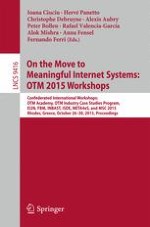This volume constitutes the refereed proceedings of the following 8 International Workshops: OTM Academy; OTM Industry Case Studies Program; Enterprise Integration, Interoperability, and Networking, EI2N; International Workshop on Fact Based Modeling 2015, FBM; Industrial and Business Applications of Semantic Web Technologies, INBAST; Information Systems, om Distributed Environment, ISDE; Methods, Evaluation, Tools and Applications for the Creation and Consumption of Structured Data for the e-Society, META4eS; and Mobile and Social Computing for collaborative interactions, MSC 2015. These workshops were held as associated events at OTM 2015, the federated conferences "On The Move Towards Meaningful Internet Systems and Ubiquitous Computing", in Rhodes, Greece, in October 2015.
The 55 full papers presented together with 3 short papers and 2 popsters were carefully reviewed and selected from a total of 100 submissions. The workshops share the distributed aspects of modern computing systems, they experience the application pull created by the Internet and by the so-called Semantic Web, in particular developments of Big Data, increased importance of security issues, and the globalization of mobile-based technologies.
